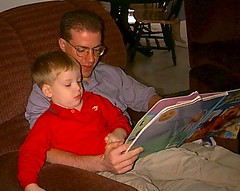by Esther Jantzen, guest poster
It’s great when children read about subjects that really interest them. Their knowledge and vocabulary expand. Kids start to read eagerly when they see their parents reading eagerly. So sit down and enjoy doing that together!
Here’s an activity to try:
1) Plan a family time when you make independent reading important (when each person reads something they choose on their own).
A weekend evening may work well, or try it on a slow summer day, after a holiday meal, on a rainy day, or when someone’s recovering from the flu and you want to keep things a little quiet.
2) Invite family members to bring what they want to read to the same room and get comfortable.
They might bring a magazine, a comic book, a novel, a newspaper, a technical manual, a cookbook, an atlas, a non-fiction work, a book about animals, a hobby manual, or anything else appropriate. Turn off the TV or radio.
3) Let everyone know that you’ll be spending at least half-an-hour together in the room, with each person quietly reading what interests them. If you have a child who is too young to read, let them look at a picture book.
4) After the quiet reading time, invite each person to talk about what they read, saying whatever they want to say. And if someone gets stuck or doesn’t know what to say, you can ask:
- What’s something that you learned?
- What did you notice?
- What was the best thing about what you read?
5) You may want to serve a snack after the reading time.
##
Family Reading Hour supports the English-Language Arts Content Standards related to reading comprehension, literary response, and delivery of oral communication.
Esther Jantzen, Ed.D, is a mother, an educator and the author of Plus It! How to Easily Turn Everyday Activities into Learning Adventures for Kids available at www.plusitbook.com and the Way to Go! Family Learning Journal available through www.jantzenbooks.com




